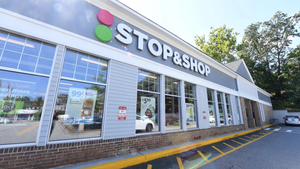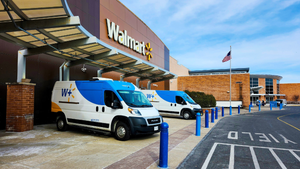- Grocery Wholesale & Distributors
- Legislation & Regulatory News
- Grocery Operations
- Foodservice at Retail
SpartanNash’s Q3 sales dip as Amazon volume lagsSpartanNash’s Q3 sales dip as Amazon volume lags
Wholesale and retail businesses reflect industrywide unit-sales pressure, executives said.

Grocery distributor/retailer SpartanNash saw overall sales decline—pulled down by lower wholesale sales with Amazon—and fell short of Wall Street’s adjusted earnings-per-share forecast in its fiscal 2023 third quarter.
For the 12-week quarter ended Oct. 7, consolidated net sales dipped 1.4% to $2.26 billion from nearly $2.3 billion a year earlier, Grand Rapids, Michigan-based SpartanNash reported Wednesday. The decrease reflects volume declines in both the wholesale and retail business segments, partially offset by higher pricing from inflation, the company said.
The net sales slip followed a 1% uptick in the second quarter and came against a tough comparison with a 10.8% gain in the 2022 third quarter.
In a conference call with analysts Wednesday morning, SpartanNash President and CEO Tony Sarsam reiterated what the company noted in the second quarter, that its wholesale volume with Amazon remains down as the retail giant sorts out changes in its grocery business.
Amazon in July had announced job cuts and an operational restructuring for its Amazon Fresh supermarket business, which encompasses 44 stores in eight states and the District of Columbia. Amazon has said it aims to refine the Amazon Fresh model to develop a more compelling grocery retail offering.
“During the last quarter, we continued to experience a decrease in sales on our Amazon business,” Sarsam told analysts in the Q3 call. “Outside of this impact, we observed positive sales trends in our wholesale segment, as well as for the consolidated company. We continue to work closely with Amazon as they manage through changes in their grocery format.” (Call transcript provided by AlphaSense.)
SpartanNash’s roster of private labels, led by Our Family, has remained a bright spot as consumers continued to grapple with relaxed but still elevated food price inflation, according to Sarsam.
“Even in an environment where national-brand volumes declined, our own-brand portfolio held strong,” he said. “Our new and refreshed own-brand products are helping consumers across all income levels to further stretch their dollars.”
Industrywide volume crunch impacts wholesale, retail
SpartanNash’s wholesale and retail businesses—like other companies across the grocery sector—continue to wrestle with lackluster unit sales, Chief Financial Officer Jason Monaco noted to analysts in the call.
“Consistent with the industry pressures, both segments were unfavorably impacted by volume headwinds,” he said.
Third-quarter net sales for distribution, including food and military wholesale, came in at $1.6 billion, down 1.7% from $1.63 billion a year ago, when sales jumped 11.3%.
“The 1.7% decrease was due primarily to demand changes within the Amazon business,” Monaco said. Year-ago sales also reflected higher levels of inflation.

Source: SpartanNash fiscal 2023 Q3 presentation
SpartanNash also pointed to a 4% throughput rate improvement in its supply chain network for Q3 versus a year ago, reflecting operational improvements. The rate was up 12.5% on a two-year stack.
Retail net sales, meanwhile, ticked down by 0.7% to $662.2 million in Q3 2023 from $666.6 million a year earlier, when SpartanNash recorded a 9.5% increase. SpartanNash said lower fuel sales shaved quarterly net sales by 0.8%. Comparable-store sales edged up 1.2% for the quarter, lifted by inflation, and built on an 8% gain in the prior-year period.
“Continued reductions in EBT benefits offered to consumers in our retail geography adversely impacted same-store sales by approximately 3% this past quarter, a trend that has accelerated in the last six months,” Monaco said, adding that SpartanNash’s private brands are helping these customers meet their grocery needs.
The retail segment at SpartanNash includes 144 corporate-owned and -operated supermarkets, down from 147 a year earlier, in Michigan, Indiana, Iowa, Minnesota, Nebraska, North Dakota, Ohio, South Dakota and Wisconsin, primarily under the Family Fare, Martin’s Super Markets and D&W Fresh Market banners.
Upgraded store locations are showing clear performance improvements, Sarsam said.
“Turning to our recently remodeled up-market stores, we are growing at double the rate of the rest of our retail portfolio due to the stores’ innovative offerings,” he explained. “We continue to reinvest in our stores and are on target to renovate or refresh 25% of the base during the [transformation] plan period from 2021 through 2025.”
Bottom line edges up
In the 2023 third quarter, SpartanNash’s reported net income totaled $11.1 million, or 32 cents per diluted share, up from $9.5 million, or 26 cents per diluted share, a year earlier, which reflected adjustments of 22 cents per diluted share, including LIFO, acquisition/integration, organizational realignment and other costs.
Adjusted net earnings (continuing operations) were $18.8 million, or 54 cents per diluted share, versus just over $20 million, or 55 cents per diluted share, in the 2022 quarter.
Analysts, on average, had projected SpartanNash’s Q3 2023 adjusted EPS at 58 cents, with estimates ranging from 55 cents to 61 cents, according to Refinitiv.
Also on the earnings side, SpartanNash posted adjusted EBITDA of $60.9 million, up 6.3% from $57.3 million in the 2022 quarter.
“Our signature strength is being the most customer-focused, innovative food solutions company. Now that we are executing on our ‘Winning Recipe’ [strategic plan], we’re even attracting former customers. They have seen our momentum and are boomeranging back to SpartanNash,” Sarsam said in the analyst call. “We’re eagerly welcoming them back into our family. They see us as a long-term strategic partner as they focus on their next phase of growth. This is a true testament to the progress we have made over the past three years.”
Based on its year-to-date performance and current outlook, SpartanNash trimmed its fiscal 2023 guidance. Full-year adjusted EPS is now forecast at $2.20 to $2.28 (versus $2.20 to $2.35 previously), while total net sales are projected at $9.65 to $9.85 billion (versus $9.65 to $9.95 billion previously). Likewise, the guidance range for adjusted EBITDA has been narrowed to between $253 million and $258 million (versus $248 million to $263 million previously).
Analysts’ consensus estimate, before to the third-quarter report, was for adjusted EPS of $2.26, with projections running from $2.22 to $2.31, according to Refinitiv.
"Inflation continued moderating throughout the third quarter (average 3% in wholesale), and Amazon Fresh formatting changes were largely the culprit of the year-over-year total sales decline. Excluding the Amazon account, net sales would have been up 1.6% instead of -1.4% as realized," Jefferies analyst Alexander Slagle wrote in a research note late Wednesday on SpartanNash's Q3 results. "On the other hand, wholesale is winning new customers and working to drive higher penetration in existing [customers], driving share gains, and retail is benefiting from rapid GLP-1 [weight-loss drug] sales growth (not seeing impact on food consumption), digital (promos, loyalty/personalized value), own brands growth (e.g. October saw launch of first foray into premium private label with Finest Reserve), value, marketing and merchandising."
*Editor's Note: Article updated with analyst comment.
Read more about:
SpartanNashAbout the Author
You May Also Like






